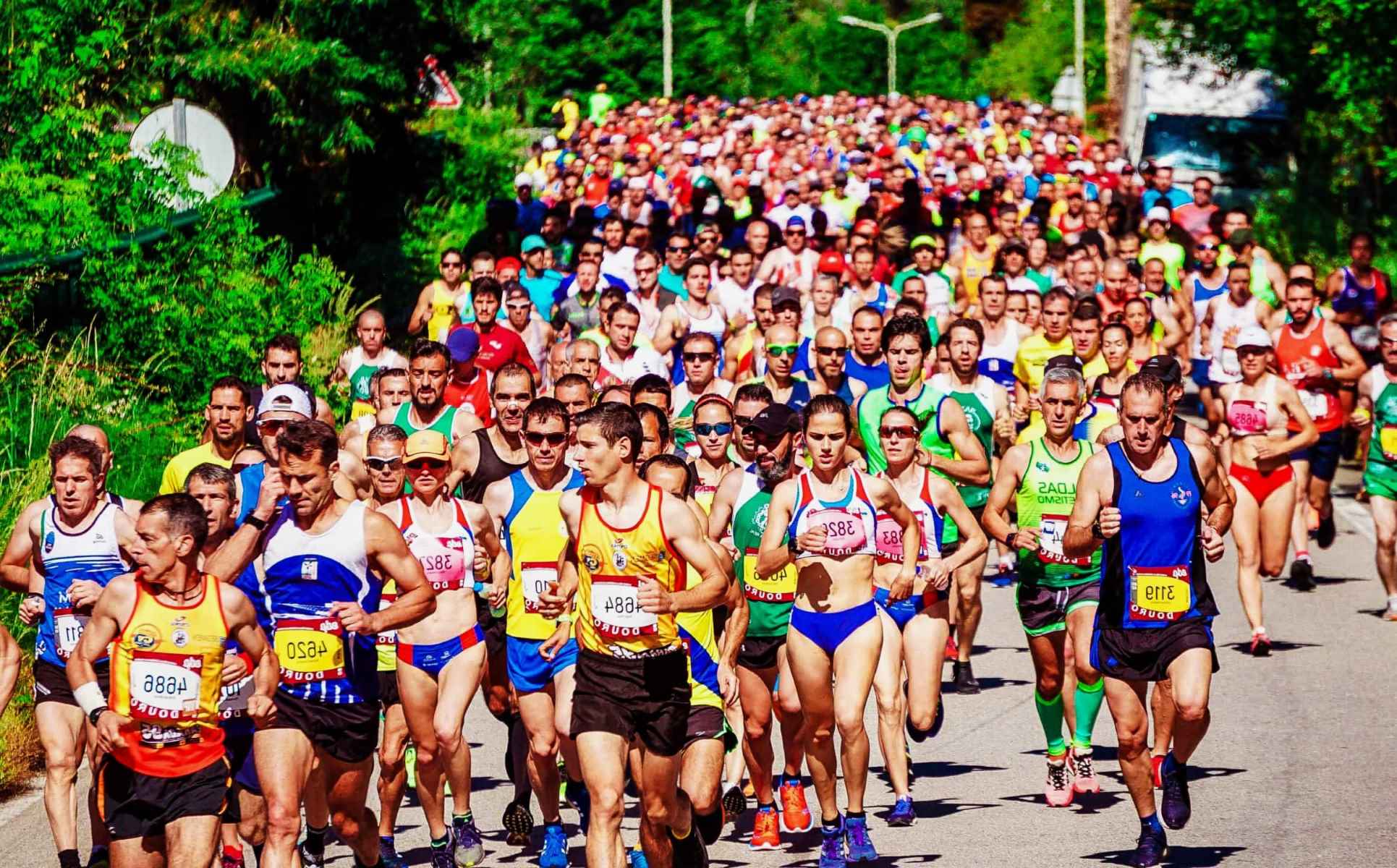Home>Races & Events>Mastering Your Marathon Race Day Strategy: Planning And Execution Tips


Races & Events
Mastering Your Marathon Race Day Strategy: Planning And Execution Tips
Published: February 27, 2024
Get expert tips for planning and executing your marathon race day strategy. Learn how to optimize your performance and experience success at races and events.
(Many of the links in this article redirect to a specific reviewed product. Your purchase of these products through affiliate links helps to generate commission for Therunningadvisor.com, at no extra cost. Learn more)
Table of Contents
Understanding the Marathon Course
Understanding the marathon course is a crucial aspect of race day preparation. Whether you're a first-time marathoner or a seasoned runner, knowing the course layout, terrain, and elevation changes can significantly impact your race day performance. Here's a comprehensive guide to mastering the marathon course and optimizing your strategy for success.
-
Course Layout: Familiarize yourself with the marathon course map. Identify the start and finish points, as well as key landmarks, aid stations, and potential challenging sections. Knowing the course layout will help you mentally prepare for the race and anticipate what's ahead.
-
Terrain and Elevation: Study the terrain and elevation profile of the marathon course. Is it a flat course, hilly, or a mix of both? Understanding the terrain will allow you to adjust your pacing and energy expenditure accordingly. For instance, on uphill segments, conserving energy and maintaining a steady effort level is essential, while downhill sections may require controlled descents to prevent muscle fatigue.
-
Weather Conditions: Consider the typical weather conditions for race day. Will it be hot, cold, windy, or humid? Understanding the potential weather challenges can help you make informed decisions regarding clothing, hydration, and pacing strategies.
-
Course Specifics: Research any specific features of the marathon course, such as narrow pathways, sharp turns, or challenging surfaces. Being aware of these details enables you to adapt your running technique and foot placement to navigate the course safely and efficiently.
-
Strategic Mile Markers: Identify strategic mile markers along the course. These could include significant landmarks, cheering sections, or mentally challenging segments. Mentally breaking down the race into smaller, manageable sections can provide a psychological boost and help you stay focused throughout the marathon.
By thoroughly understanding the marathon course, you can tailor your race day strategy to optimize performance and minimize potential obstacles. This knowledge empowers you to approach the race with confidence, adaptability, and a clear understanding of what lies ahead.
Setting Realistic Race Day Goals
Setting realistic race day goals is a fundamental aspect of marathon preparation. It involves a careful assessment of your current fitness level, past training performance, and the specific characteristics of the upcoming race. By establishing attainable objectives, you can optimize your race day experience and enhance your overall satisfaction with the event. Here's a detailed exploration of the key considerations when setting realistic race day goals:
-
Assess Your Training Progress: Reflect on your training journey leading up to the marathon. Evaluate your long runs, speed workouts, and overall mileage. Consider how your body has responded to the training load and any improvements in endurance, speed, and recovery. This assessment forms the basis for setting goals that align with your current fitness level and capabilities.
-
Consider Previous Race Performances: If you have prior marathon experiences, analyze your past race performances. Identify areas of strength and areas for improvement. Use this insight to set goals that build upon your previous achievements while addressing any limitations or challenges encountered in previous races.
-
Understand the Race Course and Conditions: Take into account the specific characteristics of the marathon course, including terrain, elevation changes, and potential weather conditions. Realistic goals should be tailored to the unique demands of the course, ensuring that they are achievable within the given race environment.
-
Establish Multiple Goals: Instead of focusing solely on a single outcome-based goal, consider setting multiple tiers of goals. This approach allows for flexibility and adaptability during the race. For instance, you can have a primary goal (e.g., achieving a personal best), a secondary goal (e.g., maintaining a consistent pace), and a tertiary goal (e.g., finishing strong regardless of time).
-
Factor in External Variables: Acknowledge external factors that may influence your race day performance, such as unexpected weather changes, unforeseen physical discomfort, or logistical challenges. By acknowledging these variables, you can set goals that accommodate potential adjustments during the race while maintaining a positive mindset.
-
Embrace Realistic Time Targets: When setting time-related goals, be mindful of your current fitness level and the nature of the marathon course. Avoid setting unrealistic time targets that may lead to unnecessary pressure or disappointment. Instead, aim for time goals that reflect your training progress and the unique aspects of the race.
By carefully considering these factors, you can establish realistic race day goals that align with your capabilities, the race environment, and your overall marathon aspirations. Setting attainable goals enhances your mental preparedness, fosters a sense of accomplishment, and contributes to a fulfilling marathon experience.
Pre-Race Nutrition and Hydration
Pre-race nutrition and hydration play a pivotal role in optimizing marathon performance and supporting overall well-being on race day. Proper fueling and hydration strategies can significantly impact energy levels, endurance, and recovery during the demanding 26.2-mile journey. Here's a comprehensive guide to pre-race nutrition and hydration, encompassing essential considerations and practical tips for marathon runners.
Establish a Nutrition Plan
Developing a well-rounded nutrition plan in the days leading up to the marathon is crucial for ensuring optimal glycogen stores and muscle recovery. Focus on consuming a balanced mix of carbohydrates, lean proteins, healthy fats, and essential vitamins and minerals. Incorporate whole grains, fruits, vegetables, lean meats, fish, nuts, and seeds into your meals to provide a diverse array of nutrients that support overall health and performance.
Hydration Preparation
Hydration is equally vital in the pre-race phase. Aim to maintain a consistent fluid intake throughout the week leading up to the marathon. While individual hydration needs vary, a general guideline is to consume at least 64 ounces of water daily, adjusting based on climate conditions and personal sweat rates. Additionally, electrolyte-rich beverages or sports drinks can help replenish essential minerals lost through sweat and support proper hydration.
Read more: Dos And Don’ts For Race Day
Carb-Loading Strategy
Carbohydrate loading, a well-established practice among endurance athletes, involves increasing carbohydrate intake in the days leading up to the marathon to maximize glycogen stores in the muscles and liver. Approximately 3-4 days before the race, gradually increase your carbohydrate consumption to around 3-5 grams per pound of body weight per day. This can be achieved through whole grains, pasta, rice, potatoes, and other complex carbohydrates.
Pre-Race Meal Timing
The timing of your pre-race meal is critical. Consume a balanced, easily digestible meal rich in carbohydrates and moderate in protein and fat approximately 3-4 hours before the race start time. This meal should provide sustained energy without causing digestive discomfort during the run. Experiment with different pre-race meal options during your training to identify what works best for your body.
Avoid Experimentation
Race day is not the time to experiment with new foods or beverages. Stick to familiar, well-tolerated foods and fluids that have been successfully incorporated into your training regimen. Avoid high-fiber, greasy, or spicy foods that may lead to gastrointestinal distress. Similarly, refrain from consuming excessive caffeine or alcohol in the days leading up to the race, as they can impact hydration and sleep quality.
Final Hydration Check
In the hours leading up to the marathon, continue to prioritize hydration. Sip on water or a sports drink to maintain optimal fluid balance. Be mindful of overhydration, as excessive fluid intake can lead to hyponatremia, a condition characterized by low blood sodium levels. Monitor your urine color to gauge hydration status, aiming for a pale yellow color indicative of adequate hydration.
In Summary
Pre-race nutrition and hydration are integral components of marathon preparation, influencing both physical performance and mental resilience. By implementing a well-structured nutrition plan, prioritizing hydration, and adhering to proven fueling strategies, you can optimize your body's readiness for the marathon challenge. Remember that individual nutrition and hydration needs vary, so it's essential to personalize your approach based on your unique physiological responses and training experiences. With careful attention to pre-race nutrition and hydration, you can enhance your race day experience and maximize your potential for a successful marathon performance.
Race Day Gear and Attire
Selecting appropriate race day gear and attire is a critical aspect of marathon preparation, directly impacting comfort, performance, and overall race day experience. From running shoes to technical apparel, each element of your race day ensemble plays a significant role in supporting your body throughout the 26.2-mile journey. Here's an in-depth exploration of essential considerations and practical tips for optimizing your race day gear and attire:
Running Shoes
Your choice of running shoes can profoundly influence your marathon performance and reduce the risk of discomfort or injury. Prioritize selecting running shoes that have been thoroughly tested and proven during your training runs. Avoid using brand-new shoes on race day, as they may lead to blisters or discomfort due to inadequate break-in time. Opt for lightweight, cushioned shoes that provide ample support and stability, tailored to your specific foot shape and running gait.
Moisture-Wicking Apparel
Wearing moisture-wicking apparel is crucial for managing sweat and maintaining body temperature throughout the marathon. Select technical running apparel made from breathable, moisture-wicking fabrics that effectively draw sweat away from the skin. Avoid cotton clothing, as it retains moisture and can lead to chafing and discomfort. Consider wearing compression gear to support muscle recovery and reduce muscle fatigue during the race.
Read more: A Three-Day-A-Week Marathon Training Plan
Socks
Invest in high-quality, moisture-wicking socks designed specifically for running. Proper running socks can prevent blisters, provide cushioning, and enhance overall foot comfort. Look for seamless, blister-resistant socks that offer targeted support and ventilation to keep your feet dry and blister-free throughout the marathon.
Race Belt or Hydration Pack
Depending on your hydration and nutrition needs, consider using a race belt or hydration pack to conveniently carry energy gels, electrolyte tablets, or a hydration reservoir. Ensure that the race belt or pack is comfortable and securely holds your essentials without causing chafing or bouncing during the run. Practice using the race belt or hydration pack during your long training runs to ensure it integrates seamlessly into your race day strategy.
Headwear and Sunglasses
If the race day weather calls for sun exposure, consider wearing a moisture-wicking cap or visor to shield your face and eyes from direct sunlight. Additionally, opt for UV-protective sunglasses to reduce glare and protect your eyes during the marathon. Choose lightweight, comfortable headwear and sunglasses that won't cause discomfort or distraction while running.
Body Glide or Anti-Chafing Products
To prevent chafing and skin irritation, apply body glide or anti-chafing products to areas prone to friction, such as inner thighs, underarms, and nipples. These products create a protective barrier that reduces friction and minimizes the risk of chafing, allowing for a more comfortable and focused running experience.
By meticulously selecting and testing your race day gear and attire, you can optimize your physical comfort, reduce the likelihood of discomfort or injury, and enhance your overall performance during the marathon. Remember to integrate your gear choices into your training runs to ensure they align with your body's needs and support your race day objectives. With the right gear and attire, you can approach the marathon with confidence, knowing that you are well-equipped to tackle the challenges ahead.
Mental Preparation and Visualization
Mental preparation and visualization are integral components of a marathon runner's race day strategy, wielding significant influence over performance, resilience, and overall race day experience. As the miles unfold and physical fatigue sets in, a strong and resilient mindset becomes a potent ally, guiding runners through the highs and lows of the marathon journey. Here's an in-depth exploration of the essential aspects of mental preparation and visualization, along with practical techniques to fortify your mental resilience for the marathon challenge.
Cultivate Mental Resilience
Building mental resilience is a cornerstone of successful marathon preparation. Embracing a positive and resilient mindset can help you navigate the inevitable challenges and discomforts that arise during the race. Engage in mental conditioning exercises, such as mindfulness meditation, visualization, and positive self-talk, to cultivate mental fortitude and emotional composure. By acknowledging and accepting the discomforts inherent in marathon running, you can develop a resilient mindset that empowers you to persevere through adversity.
Visualization Techniques
Visualization, or mental imagery, is a powerful tool for preparing the mind for the demands of the marathon. Take time to visualize yourself running strong, maintaining a steady pace, and overcoming obstacles with determination and focus. Picture yourself crossing the finish line with a sense of accomplishment and fulfillment. By vividly imagining the various stages of the race and visualizing positive outcomes, you can instill confidence, reduce anxiety, and mentally rehearse your race day performance.
Establish Mantra and Affirmations
Craft a personal mantra or affirmations that resonate with your marathon aspirations and strengths. These concise, empowering phrases can serve as anchors during challenging moments, providing a source of motivation and focus. Whether it's "I am strong and resilient" or "One step at a time," your chosen mantra can reinforce a positive mindset and bolster your resolve throughout the marathon.
Embrace Adaptive Thinking
Adopting adaptive thinking involves acknowledging and reframing negative thoughts or setbacks into constructive, solution-oriented perspectives. When faced with physical fatigue or mental fatigue, practice reframing challenges as opportunities for growth and resilience. Embrace a flexible and adaptive mindset that enables you to adjust your race day strategy while maintaining a sense of determination and optimism.
Mental Rehearsal of Race Day Scenarios
Engage in mental rehearsal by envisioning various race day scenarios, including challenging segments, unexpected weather changes, and moments of fatigue. By mentally rehearsing your responses to these scenarios, you can prepare yourself to adapt and overcome obstacles with resilience and strategic thinking. This mental preparation fosters a sense of readiness and equips you to navigate the unpredictable elements of the marathon course.
In Summary
Mental preparation and visualization are indispensable tools for marathon runners, offering a pathway to fortify mental resilience, enhance focus, and optimize race day performance. By integrating these techniques into your training regimen and race day preparations, you can cultivate a resilient mindset that empowers you to conquer the marathon challenge with confidence and determination. Remember that mental preparation is a continuous practice, and by nurturing your mental resilience, you can elevate your marathon experience and unlock your full potential as a runner.
Race Day Execution: Pacing and Strategy
Race day execution hinges on a well-crafted pacing and strategy plan, serving as the cornerstone of a successful marathon performance. The ability to maintain an optimal pace, adapt to race conditions, and strategically navigate the course is instrumental in achieving both personal and competitive goals. Here's an in-depth exploration of the pivotal elements of race day pacing and strategy, along with practical insights to guide marathon runners toward an effective and rewarding race day experience.
Establishing a Realistic Pace
Setting a realistic and sustainable pace from the start is paramount to marathon success. Avoid the temptation to begin the race at an overly ambitious pace, as this can lead to premature fatigue and diminished performance in the later stages. Instead, aim to start conservatively, allowing your body to settle into a comfortable rhythm while conserving energy for the latter miles. Embrace patience and discipline, trusting in your training and race day preparations to carry you through the marathon journey.
Negative Splits and Even Effort
Striving for negative splits, where the second half of the race is faster than the first, is a common pacing strategy employed by marathon runners. This approach capitalizes on conserving energy early on and gradually increasing pace as the race progresses. Alternatively, maintaining an even effort throughout the marathon can be equally effective, particularly on challenging courses or in adverse weather conditions. Experiment with different pacing strategies during your training runs to identify the approach that best aligns with your strengths and race day objectives.
Strategic Fueling and Hydration
Integrating a strategic fueling and hydration plan into your pacing strategy is essential for maintaining energy levels and staving off fatigue. Identify key points along the course where you will consume energy gels, hydration fluids, or electrolyte supplements to replenish vital nutrients and maintain hydration. Practice your fueling strategy during long training runs to refine the timing and quantity of intake, ensuring that it complements your pacing plan without causing digestive discomfort.
Mental Check-Ins and Focus Points
Throughout the marathon, engage in regular mental check-ins to assess your physical and mental state. Identify specific focus points along the course, such as mile markers, scenic landmarks, or cheering sections, to break down the race into manageable segments. By maintaining focus on these checkpoints, you can stay present in the moment and avoid becoming overwhelmed by the magnitude of the entire distance. Embrace positive self-talk and mental reinforcement to bolster your resolve and maintain a resilient mindset.
Adaptability and Contingency Planning
While a well-defined pacing and strategy plan is crucial, it's equally important to remain adaptable and responsive to unforeseen race day developments. Be prepared to adjust your pace and strategy in response to weather changes, unexpected course conditions, or personal physical fluctuations. Embrace a flexible mindset that allows for strategic adjustments while staying committed to your overall race day objectives.
In Summary
Race day execution, centered on pacing and strategy, demands a delicate balance of physical prowess, mental fortitude, and strategic acumen. By honing your pacing skills, integrating a comprehensive strategy, and remaining adaptable to race day dynamics, you can optimize your marathon performance and elevate your overall race day experience. Remember that race day execution is a dynamic process, requiring a blend of preparation, resilience, and strategic decision-making. With a well-crafted pacing and strategy plan, you can embark on the marathon journey with confidence, determination, and a clear pathway to achieving your race day aspirations.
Dealing with Unexpected Challenges
Marathons are renowned for their unpredictability, presenting runners with a myriad of unexpected challenges that can test both physical and mental resilience. As marathoners embark on the 26.2-mile journey, they must be prepared to confront and overcome a diverse array of unforeseen obstacles that may arise during the race. Here's a comprehensive exploration of effective strategies for dealing with unexpected challenges, empowering runners to navigate the uncertainties of the marathon with adaptability and resolve.
Mental Flexibility and Adaptability
Maintaining mental flexibility is paramount when facing unexpected challenges during a marathon. Whether it's sudden changes in weather, unanticipated physical discomfort, or unforeseen course obstacles, embracing a mindset of adaptability enables runners to respond thoughtfully and decisively. By acknowledging the dynamic nature of the marathon environment, runners can adjust their expectations and strategies in real-time, mitigating the impact of unexpected challenges on their overall race day experience.
Positive Reframing and Resilient Thinking
When confronted with unexpected challenges, adopting a mindset of positive reframing and resilient thinking can bolster a runner's ability to overcome adversity. Rather than viewing challenges as insurmountable obstacles, reframing them as opportunities for growth and mental fortitude can instill a sense of empowerment and determination. Embracing a resilient mindset allows runners to navigate unexpected challenges with composure and tenacity, ultimately enhancing their capacity to persevere through the uncertainties of the marathon.
Strategic Problem-Solving and Contingency Planning
Effective problem-solving and contingency planning are essential skills for addressing unexpected challenges during a marathon. Whether it's a sudden onset of muscle cramps, a change in race course conditions, or logistical disruptions, having a strategic contingency plan in place empowers runners to respond proactively. This may involve adjusting pacing, modifying hydration and fueling strategies, or seeking support from race volunteers and medical personnel. By anticipating potential challenges and devising response strategies in advance, runners can approach the marathon with a sense of preparedness and resourcefulness.
Support Network and Encouragement
Drawing upon the support of fellow runners, spectators, and race volunteers can provide invaluable encouragement and assistance when facing unexpected challenges. The camaraderie and collective spirit of the marathon community can serve as a source of motivation and resilience during challenging moments. Whether it's a word of encouragement from a fellow runner or the unwavering support of spectators lining the course, leveraging the positive energy of the race environment can bolster a runner's resolve and determination in the face of unexpected challenges.
Reflective Adaptation and Learning
After overcoming unexpected challenges during a marathon, engaging in reflective adaptation and learning is instrumental for personal growth and future race preparedness. Taking the time to reflect on the challenges encountered, the strategies employed, and the lessons learned fosters a deeper understanding of one's capabilities and areas for improvement. This reflective process enables runners to refine their approach to handling unexpected challenges, ultimately enhancing their resilience and adaptability for future marathon endeavors.
By embracing these strategies for dealing with unexpected challenges, marathon runners can navigate the uncertainties of the race with poise, determination, and a proactive mindset. The ability to adapt, reframe challenges, and draw upon internal and external sources of support empowers runners to conquer the unexpected and emerge from the marathon experience with newfound resilience and fortitude.
Read more: Marathon Training: A 10-Day Cycle
Post-Race Recovery and Reflection
Post-race recovery and reflection are integral components of the marathon experience, encompassing physical recuperation, mental processing, and the assimilation of insights gleaned from the race day journey. As runners cross the finish line and conclude their 26.2-mile endeavor, the focus shifts from the immediate aftermath of the race to the essential practices that facilitate recovery and the introspective process of reflecting on the marathon experience.
Physical Recovery
The immediate post-race period is characterized by the need for comprehensive physical recovery. Runners should prioritize hydration, replenishing depleted glycogen stores, and engaging in gentle, restorative activities to facilitate muscle recovery. Embracing post-race nutrition, including a balance of carbohydrates, proteins, and healthy fats, supports the body's repair processes and aids in replenishing energy stores. Additionally, incorporating light stretching, foam rolling, and low-impact activities can alleviate muscle soreness and promote circulation, expediting the recovery process.
Rest and Regeneration
Rest is a cornerstone of post-race recovery, allowing the body to recuperate from the physical demands of the marathon. Adequate sleep, characterized by both duration and quality, is essential for muscle repair, immune function, and overall well-being. Embracing a period of active recovery, which may involve light walking or gentle yoga, can enhance circulation and alleviate stiffness while promoting mental relaxation and emotional restoration.
Emotional Processing and Reflection
The post-race phase provides an opportune moment for emotional processing and reflective contemplation. Runners are encouraged to engage in introspection, acknowledging the highs and lows of the marathon experience. Reflecting on moments of triumph, perseverance through adversity, and the collective spirit of the running community fosters a sense of gratitude and accomplishment. Similarly, acknowledging areas for growth, lessons learned, and personal achievements contributes to a holistic understanding of the marathon journey.
Gratitude and Celebration
Expressing gratitude for the support of family, friends, fellow runners, and race volunteers is a meaningful aspect of post-race reflection. Embracing the collective energy and camaraderie of the marathon community reinforces a sense of connection and appreciation for the shared experience. Celebrating personal achievements, regardless of race day outcomes, underscores the resilience and dedication demonstrated throughout the marathon, fostering a positive and affirming perspective.
Long-Term Planning and Goal Setting
Looking beyond the immediate post-race recovery phase, runners can engage in long-term planning and goal setting. This may involve contemplating future race aspirations, refining training strategies, and setting new objectives based on the insights gained from the marathon experience. Establishing a balanced approach to recovery, training, and future endeavors contributes to sustained motivation and continued growth as a runner.
In essence, post-race recovery and reflection encompass a multifaceted process that extends beyond physical recuperation to encompass emotional assimilation, gratitude, and future-oriented planning. By embracing these practices, runners can honor the marathon experience, derive meaningful insights, and embark on the next phase of their running journey with renewed vigor and purpose.






